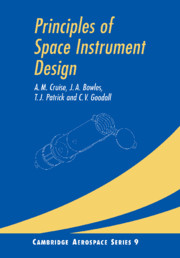Book contents
Preface
Published online by Cambridge University Press: 12 November 2009
Summary
Scientific observations from space require instruments which can operate in the orbital environment. The skills needed to design such special instruments span many disciplines. This book aims to bring together the elements of the design process. It is, first, a manual for the newly graduated engineer or physicist involved with the design of instruments for a space project. Secondly the book is a text to support the increasing number of undergraduate and MSc courses which offer, as part of a degree in space science and technology, lecture courses in space engineering and management. To these ends, the book demands no more than the usual educational background required for such students.
Following their diverse experience, the authors outline a wide range of topics from space environment physics and system design, to mechanisms, some space optics, project management and finally small science spacecraft. Problems frequently met in design and verification are addressed. The treatment of electronics and mechanical design is based on taught courses wide enough for students with a minimum background in these subjects, but in a book of this length and cost, we have been unable to cover all aspects of spacecraft design. Hence topics such as the study of attitude control and spacecraft propulsion for inflight manœuvres, with which most instrument designers would not be directly involved, must be found elsewhere.
The authors are all associated with University groups having a long tradition of space hardware construction, and between them, they possess over a century of personal experience in this relatively young discipline.
- Type
- Chapter
- Information
- Principles of Space Instrument Design , pp. xiii - xivPublisher: Cambridge University PressPrint publication year: 1998

